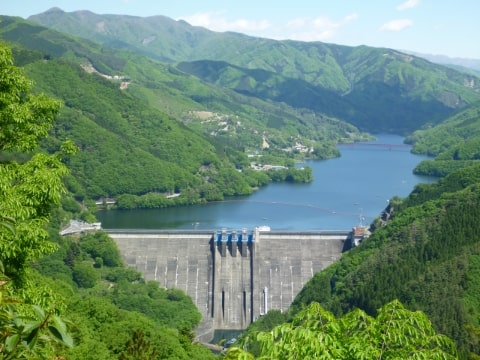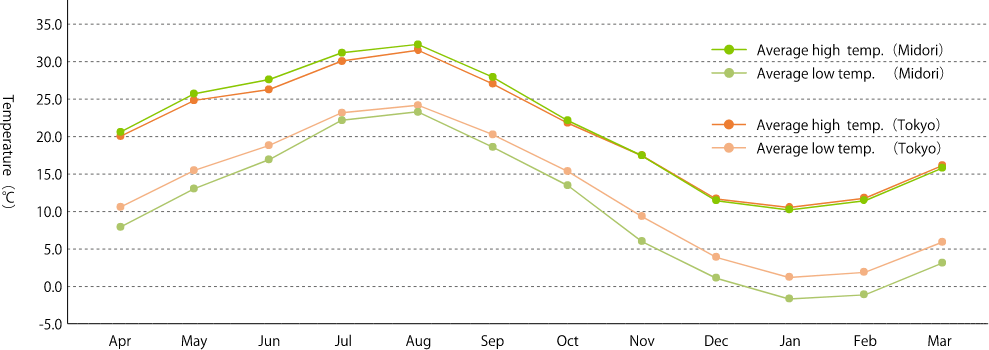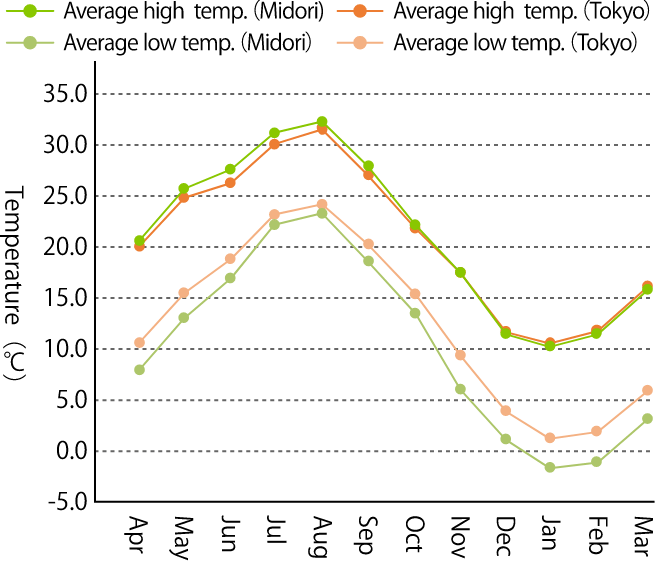aboutAbout Midori City
- Top
- About Midori City
History and Natural Features
Midori City was established on March 27, 2006, by the merger of three districts including the town of Kasakake, the town of Omama, and the village of Azuma. It is located in the eastern part of Gunma Prefecture, and takes around 2 hours by train from Tokyo. With a total area of 208.42 square kilometers, mountain forests cover 80 percent of the city. It borders Kiryu City in Gunma and Nikko City in Tochigi. The city stretches from north to south with the Ashio Mountain Range in the north. The mountains are the source of the Watarase River that flows through the city from northeast to southeast.
Azuma area, located in the northern part of the city is covered by vast mountain forests, and villages are established along the Watarase River. Kusaki Dam is located in the upper reach of the river, storing abundant water, playing an important role of supplying water to the Tokyo Metropolitan Area.
In the Omama area, which stretches from the northern to the central part of the city, water flowing down the Watarase River over a long period of time has built up an alluvial fan. "Mama" included in the name of the town "Omama" is derived from a cliff, which was created by fluvial terraces. This shows how the Watarase River has been playing an important role in the lives of the people.
The Kasakake area in the south takes its name from a traditional mounted archery called "Kasagake". It has been long known as a farming region, and recently it has become a lively neighborhood as many homes have been developed.

Transportation
The area where Midori City is located has been developed as an area where many people passed through, being a post town on the Akagane Highway used to deliver copper from the Ashio copper mine, and a trading center of silk.
Currently, the National Route 122 runs south to north from Nikko City of Tochigi Prefecture, and Route 50 runs east to west from Maebashi City into Ibaraki Prefecture. Ota-Yabuzuka Interchange on the Kita-Kanto Expressway is located around the southern part of the city, and recently an access road to the interchange has been constructed.
There are 4 railroad lines operating in the city, including JR Ryomo Line, Tobu Railway Kiryu Line, Jomo Electric Railway and Watarase Keikoku Railway. The Watarase Keikoku Railway is popular among railway fans across the nation, and is a tourist attraction that represents the area.
Climate
Midori City has many nice clear days throughout the year. You can enjoy the clear blue skies all around the seasons.
The colorful Spring when flowers bloom simultaneously in the mountains. Summer with the beautiful contrast of the blue sky and the greens. Autumn when the mountains are painted yellow and red. Winter when you feel the crisp winter air with dry north wind known as the "strong winds of Joshu". The beautiful seasons created by the rich nature including the mountains, rivers and lakes. This is what makes Midori City so attractive.
- Characteristics
- The average temperature of the city is about the same as Tokyo. However, due to the geography of the city, which stretches from north to south creating a difference in elevation, there is a large temperature gap between the northern and southern part of the city. Cherry blossoms bloom at different times (2-3 week gap) in the north and the south.
Hours of daylight are long throughout the year, and it rarely snows during winter. However, the apparent temperature is much lower due to the strong dry wind, which is distinctive in the Joshu region. There are days when the temperature goes below zero, so winter tires are necessary on roads going to the mountains and some paths through the forests.
- ElevationSource: Geospatial Information Authority of Japan
(The elevation of each location shown is an estimate.) 
- Max /Min temp.Source: Japan Meteorological Agency Data
(Average temperature of 2017-2019. Temperatures shown are measured in Kiryu City.) 

Season and Clothing
| Climate | Clothing | |
|---|---|---|
| Spring | Although it is warm during the day, there are many days when it is cold in the morning and evening, and the average minimum temperature in April goes below 10ºC (50°F). Cherry blossoms bloom a little later than in Tokyo, and since elevations differ between north and south, the flowers bloom from south to north over 2-3 weeks. During Golden Week (end of April to early May), rhododendron albrechtii (Rhododendron quinquefolium, and Rhododendron pentaphyllum Maxim. var. nikoense Komatsu) bloom on Mt. Kesamaru, pleasing the eyes of the hikers. | It may be a good idea to carry a jacket when you are going to enjoy the cherry blossoms, since it can get chilly in the morning and evening, or in the shade. The sunshine gets strong around May, and on a clear day you may even wear short-sleeved clothing in the sun. It is recommended to have with you something you can easily wear and take off according to the weather. |
| Summer | Average temperature is high and there are days when the downtown area reaches one of the highest temperatures recorded in Japan. You must take precautions against heatstroke. Temperatures by the river and lake in the northern area are relatively lower than the downtown area, so many people come for leisure. On extremely hot days, be aware of sudden thunderstorms in the evening. | It gets extremely hot from July to August, and wearing a short-sleeved T-shirt or polo shirt is recommended. Do not forget to put on sunscreen and/or sunglasses to protect you from the sun. In case of sudden rain, carrying umbrellas or change of clothes may be a good idea. If you are planning to visit high-altitude destinations, such as near the peak of Mt. Kesamaru, you will need a jacket even in summer. |
| Autumn | There will be hot days during the first half of the season, but it will cool down gradually and begin to feel like autumn. Towards the end of October, leaves will start to turn into autumn colors from the north, and can be enjoyed until the end of November. You will begin to see frost around October in Mt. Kesamaru, and chilly wind blows on its peak. | Around mid-October, it begins to get cold in the morning and evening, so be sure to carry a jacket. There are many warm days during the autumn foliage season, however as you travel north, the temperature will drop. If you are planning to ride the Watarase Keikoku Railway Trolley Train, which is very popular during the autumn foliage season, it is recommended that you bring a wind resistant jacket. |
| Winter | Even on days when it is warm during daytime, the temperature can drop below zero in the morning and evening. The temperature gap is larger compared to Tokyo. Cold, strong dry wind begins to blow around December. It is rare to see snow in downtown, but there are snowy days when you can see some snow on the ground in the town of Azuma located in the northern part of the city. | Make sure to wear clothing that will keep you warm, including a wind resistant jacket/coat, and if you are going outdoors wearing a hat, scarf and gloves is recommended. Humidity is low and the air is dry, so carrying a lip balm and/or hand cream is also a good idea. |
Tourist Information
| Midori City Tourism Association | 1034-5 Omama, Omama-cho, Midori City, Gunma | Tourist guide, Events(irregular basis), and Souvenirs |
|---|---|---|
| Omama Station Tourist Information Center | 1358-4 Omama, Omama-cho, Midori City, Gunma | Tourist guide |
| Midori City Tourism Division | 1511 Omama, Omama-cho, Midori City, Gunma | Travel inquiries, Pamphlets |


